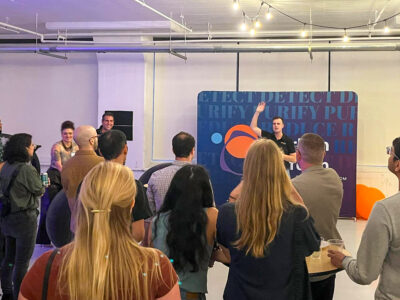[vimeo 25562357 w=420 h=315]
The following is a report done in partnership with Temple University’s Philadelphia Neighborhoods Program, the capstone class for the Temple Journalism Department.
The Central High School Robolancers in Olney should be designing a robot for a different task than usual: one that gives out a good pat on the back. The team of robot-building students placed in the quarterfinals of the local-regional For Inspiration and Recognition of Science and Technology robotics competition in Philadelphia, and took first-place overall in the local-regional Boosting Engineering Science and Technology competition.
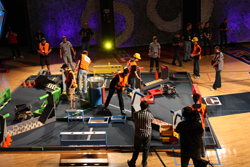
The Robolancers competed in grueling competitions which required them to put in long hours designing, building and programing their robots. (Photo courtesy of Central High Robolancers)
After winning the BEST regional, the team traveled south to Alabama for the BEST south-regional competition, where they took sixth-place overall. The top eight teams competed in the national BEST competition in Florida, and the Robolancers placed second in video presentation and third in engineering notebook.
The team also competed in the local underwater Marine Advanced Technology Education competition for the first time this year, placing first in presentation but taking second in the overall competition after a blown fuse disabled their robot. They then went on to Texas for the international MATE competition in Houston earlier this month.
Daniel Ueda, a former mechanical engineer, is director of the Robolancers. He serves as a teacher and guide to the students, with help from a few parents and mentors from local companies like Boeing.
“We need more adults who understand engineering to be involved in the mechanical design process,” Ueda said in an interview with Technically Philly at his lab in Central High.
- The Robolancers’ robots were designed, built and programmed entirely by the students.
“There are so many components to a robot, and so many different people working on it, that we need more people who know what they are doing,” Ueda continued, gesturing to the various electrical and mechanical components that cluttered the sparse furniture of the room.
“The designs are completely done and built by the students,” Ueda said. “I’m just here to guide them along the way.”
The competitions require teams to put together a full engineering document, complete with computer-assisted-design drawings, electrical schematics and programming, as well as an explanation of the process and how it works. In addition to the lengthy paperwork, students must also give an oral presentation in front of engineers and also maintain a vendor table where they must pitch their ideas and demonstrate their knowledge.
“Competitions vary year to year, but the parameters are basically the same,” Ueda said. “The whole gamut of engineering is included in these competitions. It goes beyond just building a robot.”
STEM [science, technology, engineering and mathematics] programs like the FIRST, BEST and MATE competitions are working at schools like Central High to engage and interest students in engineering.
“This year we graduated six students, and of those six, four are going into mechanical engineering,” Ueda said. “It is amazing that some of the kids come in here knowing nothing about engineering, and then graduate and enter into the professional field and do wonderful things.
“The things they are doing now in high school compares to things I did in my senior year of college,” Ueda added.
Being a part of the Robolancers not only challenges students academically, but also socially.
“You have kids start freshman year who don’t really fit in sometimes,” Ueda lamented. “But throughout the four years in the robotics program, they learn how to be socially comfortable with themselves.
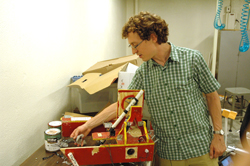
Daniel Ueda, director of the Central High Robolancers, demonstrated how a robot works at the team’s Central High lab.
“They develop so many useful skills that they can use in life—reading, writing, teamwork—that don’t come as easily to some of the students as others,” Ueda said.
Kevin Mai, head programmer of the Robolancers and a recent graduate of Central, agreed that STEM programs such as the FIRST, BEST and MATE competitions were invaluable learning tools for him and his peers.
“Winning regionals and making it to nationals meant a lot to us as a team,” Mai said. “We really bonded together as a family.
“These programs really teach us to think outside of the box in ways that normal classes do not do,” Mai said. “Math and English classes just teach us to memorize stuff, but with robotics we get to see our skills actually applied in real-life.”
Mai and his peers often volunteered long hours after school to work on their robots, sometimes staying until the building closed down at 11 p.m. “That is what is fun about robotics though—the challenge,” Mai said.
Most kids, not to mention adults, think robots are cool, so getting them interested is a job that really does itself. Events like the Robotic Expo during Philly Tech Week and the School District of Philadelphia‘s Summer Bridge program allow students to test robots and experience how they work. The biggest problem he faced engaging students, Ueda said, was getting girls involved in the mechanical aspects.
“The girls are always very involved in the writing process and presentations,” Ueda said, “but they generally aren’t as interested in using tools as the boys.”
Robotics programs are becoming more popular each year, Ueda said, but communication between schools needs to improve.
“Some schools have more resources than others,” Ueda said. “We have decent financial support from the district as well as from generous alumni.”
Ueda has been reaching out to other schools in Philadelphia to interest pupils across the county in robotics and engineering.
“We’ve been working with the Philadelphia Girls School to start a BEST team there next year,” Ueda said.
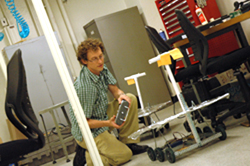
The Robolancer’s robots were designed, built and programmed entirely by the students.
Ueda and his students will visit the neighboring school twice a week to train the students and assist them in building a robot.
“We are trying to work more this year on getting other kids in the city and other teams involved,” Ueda said.
STEM programs are something teachers like Ueda and students like Mai said they want to see available for every interested student.
“These programs should be available for younger students, too,” Mai said.
“My younger brother is interested in learning software development, but his middle school doesn’t have any STEM programs,” he continued. “This is something that every school district in Philadelphia should have, not just three or four.”
Before you go...
Please consider supporting Technical.ly to keep our independent journalism strong. Unlike most business-focused media outlets, we don’t have a paywall. Instead, we count on your personal and organizational support.
3 ways to support our work:- Contribute to the Journalism Fund. Charitable giving ensures our information remains free and accessible for residents to discover workforce programs and entrepreneurship pathways. This includes philanthropic grants and individual tax-deductible donations from readers like you.
- Use our Preferred Partners. Our directory of vetted providers offers high-quality recommendations for services our readers need, and each referral supports our journalism.
- Use our services. If you need entrepreneurs and tech leaders to buy your services, are seeking technologists to hire or want more professionals to know about your ecosystem, Technical.ly has the biggest and most engaged audience in the mid-Atlantic. We help companies tell their stories and answer big questions to meet and serve our community.
Join our growing Slack community
Join 5,000 tech professionals and entrepreneurs in our community Slack today!

A new model for thinking about how to grow regional economies: the Innovation Ecosystem Stack
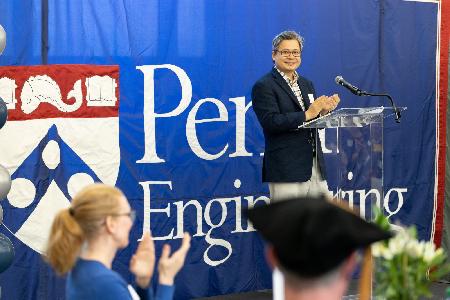
Penn dean is a startup founder and ‘engineer at heart’ who loves the connection between education and business

20 tech community events in October you won’t want to miss
